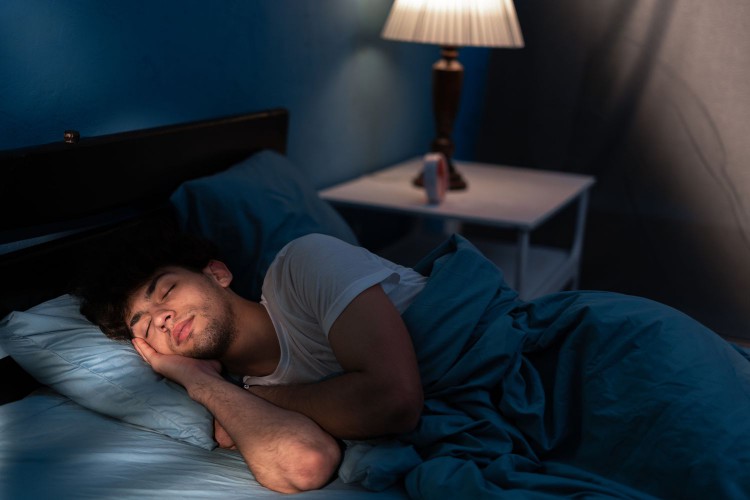Do you rub your feet together to help you fall asleep?
When dealing with stress or anxiety, many of us engage in certain behaviors and habits without even knowing it. Habits like biting your nails, playing with your hair, and cracking your knuckles can offer a sense of comfort and distraction during anxious moments.
When it comes to relaxation and falling asleep, some people turn to a self-soothing movement called “cricket feet.”
Cricket feet, or cricketing, is the repeated physical movement of rubbing one foot against the other, often while trying to fall asleep, Lee Phillips, LCSW, CSAC, a psychotherapist and certified sex and couples therapist, told Health.
The name, unsurprisingly, comes from crickets. The insects make chirping sounds when they rub their long hind legs together on their wings, or when they simply rub their wings together, Phillips explained.
“Cricket feet” has garnered millions of views on TikTok, with creators singing its praises.
Although this behavior isn’t widely recognized in clinical literature, it’s similar to repeating calming and self-soothing actions and motions, Jennifer Worley, LMFT, a licensed marriage and family therapist and clinical director of First Light Recovery, told Health.
“Engaging in such actions can be a self-soothing mechanism, similar to rocking or tapping,” she said.
Here’s why people may be inclined to cricket feet and whether or not it actually helps with sleep.

Getty Images / Andrii Lysenko
There isn’t a one-size-fits-all explanation for why people engage in cricketing, however, Phillips said that some people might do it for physical comfort, to self-soothe, or as a way to cope with anxiety.
Repetitive behaviors, like cricket feet, can help regulate the nervous system, reduce anxiety or stress, settle down, and relax, he explained.
“Physical movements, including this behavior, help relax the body when tired and stressed,” Phillips said. “It is interesting that half of the time, people do not even know they are aware they are doing it.”
Cricketing may also serve as a form of an emotional regulator or a self-soothing behavior for some people, especially those who have neurodivergent disorders, such as autism and attention deficit hyperactivity disorder (ADHD), Jade Wu, PhD, a board-certified sleep psychologist, and Mattress Firm Sleep Advisor, told Health.
Another possible explanation for why an individual may engage in cricket feet, particularly in the evening or in bed is because it’s a symptom of restless legs syndrome, Wu said.
She explained that restless legs syndrome is a neurological disorder that causes an urge to move the legs (and in rare cases other body parts), accompanied by uncomfortable sensations in the legs like tightness, tingling, pulling, or pain.
“This usually happens in the evenings, and moving/rubbing the legs relieves the sensation,” Wu said. “This is often considered a sleep-related disorder because it does tend to disrupt sleep.”
There are a few groups of people who may benefit from practicing cricketing.
According to Phillips, cricket feet can work for some people who experience anxiety, but also for those who have neurodivergent disorders such as autism and ADHD.
That’s because people who share these disorders are often overstimulated. Therefore, “they find cricketing to be soothing in reducing overstimulation,” Phillips said.
He explained that some anecdotal evidence suggests that repetitive movements such as rubbing one foot against the other can activate the release of feel-good neurotransmitters like oxytocin and endorphins, “which can add a calming effect to the body.”
That said, generally, there’s not enough evidence to suggest that purposefully doing this behavior (not responding to an urge, but rather, deciding to do it) is helpful for sleep, Wu said.
In addition, someone may naturally feel an urge to cricket feet as a self-soothing behavior or as a relief for Restless Legs Syndrome, however, taking up a new practice of cricketing is unlikely to help.
“If someone naturally already does this as a self-soothing behavior, it’s probably not a conscious decision to do cricketing,” Wu said. “And if you don’t naturally have the urge to do it, then it will not likely be soothing or helpful with sleep if you start.”
At this time, there are no known harmful impacts if people rub their feet together, Phillips said.
Rather, cricketing can be seen as a neutral or positive behavior because “it has more positive outcomes than negative ones,” he said.
For instance, it can help calm the nervous system, help people relax, and is used for self-soothing.
Cricketing could also be considered a neutral habit, similar to thumb-sucking in children.
“It’s not inherently harmful but is a personal behavior used to self-soothe,” Worley said.
Furthermore, she said there’s little evidence to suggest that cricketing is detrimental or harmful to one’s health, particularly when it doesn’t cause pain or interfere with sleep quality.
“If an individual finds the action calming and it does not interrupt their sleep or the sleep of others, it’s likely harmless,” Worley said.
However, if the habit becomes compulsive, disruptive, or associated with discomfort, it would be wise to consult with a healthcare professional.
For those who are looking for alternative methods to help settle into sleep, several well-established practices promote relaxation and improve sleep quality, Worley said. These include: